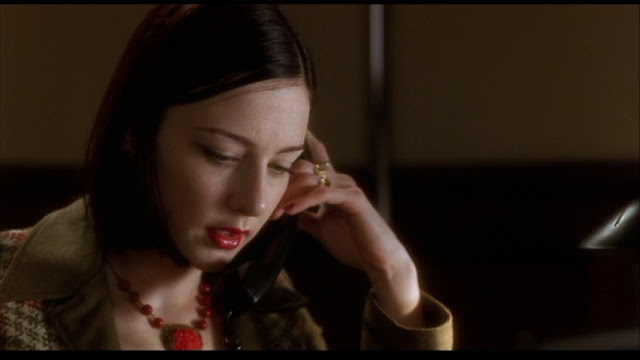


In Jung, a mandala is the "symbol of the center, the goal, or the [Self] as psychic totality; self-representation of a psychic process of centering; production of a new center of personality. This is symbolically represented by the circle, the square, or the quaternity, by symmetrical arrangements of the number four and its multiples."[a] A disturbed mandala is "Any form that deviates from the circle, square, or equal-armed cross, or whose basic number is not four or its multiples."[a] Top left: Adam's view while driving to his meeting with the Cowboy. Note that the lights from the street lamps each consist of (equal-armed) crosses (click image to enlarge). In accordance with the foregoing from Jung, each cross can be taken to be a type of mandala, indicating that the scene which is about to transpire (Adam's encounter with the Cowboy), has to do with attaining psycic totality (i.e., psychological wholeness).[b] Top right: A short while before Adam leaves for his meeting with the Cowboy, the hotel manager, Cookie, speaks briefly with him. There are three persons involved in the Cowboy scenario itself: Adam, Cynthia (above left - the woman who tells Adam. by phone, that he is supposed to meet with the Cowboy), and the Cowboy himself (above right, speaking with Adam). The grouping of three represents a disturbed mandala, indicating a problem in the dreamer's (Diane's) individuation process (i.e., a problem with her attempt to attain wholeness). If Cookie had actually been involved in the scenario (e.g., if he had known that Adam was going to meet with the Cowboy), there would have been four persons involved in the scenario, representing a full quaternity; thus, Cookie is the 'missing person' who is needed to form a grouping of four.

Later in the movie, we again see cross-shaped lights when Betty and Rita flag down a cab to take them to Club Silencio. This indicates that the club scenario itself has to do with attaining psychological wholeness.


The same man who played Cookie is now the emcee at Club Silencio (top left). The club scenario involves five significant persons: the emcee, Rita and Betty (top right), the magician (the man performing onstage - above left), and Rebekah Del Rio (the singer, above right). The emcee's sole job is to introduce Del Rio. By "significant" as used here, is meant that these are the only five persons who actually speak during the scenario: Betty and Rita (the scenario begins with Rita saying "silencio" in her sleep, while her and Betty are at home just prior to going to the club), and the other three persons just mentioned. (A blue-haired lady in the club, not pictured here, doesn't speak until the very end of the movie.) This grouping of five is similar to the grouping of three depicted earlier, in that it is 'off by one' from a proper quaternity. Thus, it too indicates a problem or abnormality with Diane's individuation process. Note that the man who played Cookie earlier is now the 'extra person' - the magician himself could just as well have introduced Del Rio.
a. Jung, C.G. Memories, Dreams, Reflections. Recorded and edited by Aniela Jaffé. Trans. Richard and Clara Winston. Vintage Books, 1989. Glossary, "Mandala". Google Books. URL = https://books.google.com.
b. "Only gradually did I discover what the mandala really is:...[T]he wholeness of the personality, which if all goes well is harmonious, but which cannot tolerate self-deceptions."(--Jung, C.G., Memories, Dreams, Reflections, Google Books, p. 212, URL = https://books.google.com.)


